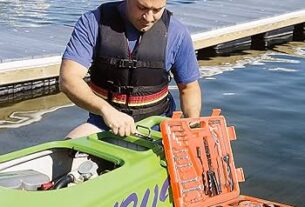Are you tired of your air tools rusting or not performing as they should? If so, you’re not alone. Properly oiling your air tools is crucial to their longevity and performance. In this article, we’ll cover everything you need to know about how to oil air tools effectively.
Why Is Oiling Important?
Before we dive into the details of how to oil air tools correctly, let’s first understand why it’s important. Air tools are mechanical devices that rely on compressed air to function. Without proper lubrication, friction can cause damage and wear over time, leading to decreased efficiency and eventual failure.
Oil also helps prevent rust and corrosion by forming a protective layer on the tool’s surface. Regularly oiling your air tools can extend their lifespan significantly.
What Type of Oil Should You Use?
When it comes to choosing the right oil for your air tools, there are several options available. However, not all oils are created equal.
Firstly, avoid using motor oil or any other type of oil that isn’t specifically formulated for air tools. These types of oils can cause damage to the tool’s internal components over time.
Instead, use a high-quality pneumatic tool oil that is designed explicitly for air-powered tools. These oils contain additives that provide superior lubrication and protection against rust and corrosion.
Some popular brands include Ingersoll Rand 10P Edge Series Premium Lubricant, DeWalt D55001 Synthetic Compressor Oil, and Senco PC0344 Pneumatic Tool Oil.
How Often Should You Oil Your Air Tools?
The frequency with which you should oil your air tools depends on how often you use them. Generally speaking, it’s a good idea to oil them after every use or at least once a day if you use them extensively.
If you’re working in a particularly dusty environment or using your air tools for heavy-duty applications, you may need to oil them more frequently.
How to Oil Your Air Tools
Now that we’ve covered the basics let’s dive into how to oil your air tools properly. Follow these steps:
Step 1: Disconnect the Tool from the Air Supply
Before oiling your air tool, always disconnect it from the air supply. This will prevent any accidental activation of the tool while you’re working on it.
Step 2: Clean the Tool
Use a dry cloth or compressed air to clean any debris or dirt from the tool’s surface. This will ensure that no contaminants get inside the tool when you’re oiling it.
Step 3: Apply Oil to the Tool
Using your pneumatic tool oil, apply a few drops directly into the air inlet of the tool. Be sure not to overfill as this can cause damage.
Step 4: Activate the Tool
After applying oil, activate the tool for a few seconds with no load to distribute the oil evenly throughout its internal components.
Step 5: Wipe Off Excess Oil
Using a clean cloth, wipe off any excess oil from the tool’s surface. This will prevent any dust or debris from sticking to it and causing damage over time.
Additional Tips for Maintaining Your Air Tools
In addition to regular oiling, there are other things you can do to keep your air tools in top condition:
– Keep them clean and free of debris.
– Store them in a dry place away from moisture.
– Use regulators and filters to ensure clean, dry air flow.
– Replace worn or damaged parts promptly.
Conclusion
In conclusion, proper maintenance of your air tools is essential for their longevity and performance. Regularly oiling your air tools using high-quality pneumatic tool oil is one of the most critical aspects of this maintenance routine.
By following our step-by-step guide on how to oil your air tools correctly, you can ensure that your tools last for years to come.
References:
– “How to Properly Oil Your Pneumatic Tools.” Ingersoll Rand, 17 June 2021, https://www.ingersollrand.com/en-us/power-tools/pneumatic-tools-and-accessories/how-to-properly-oil-your-pneumatic-tools.
– “Air Tool Lubrication: What You Need to Know.” Senco, https://www.senco.com/know-how/air-tool-lubrication.




